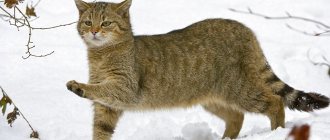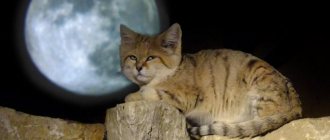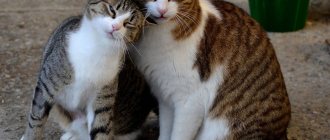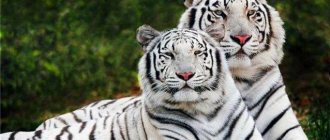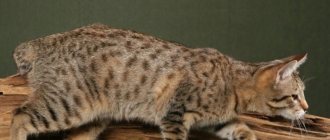Admin 08/13/2016 0 Comments
Wild
wild cats, cat breeds
Jaguarundi is a wild predatory animal that belongs to the cat family mammals . Depending on the place where this cat is common, it has about forty names. From a scientific point of view, the origin of the word jaguarundi originates in the Guaranese language and has two components: yagua - “carnivorous predator”, irundi - “four”, or, more likely, hung`I - “orange-brown”.
Characteristics of appearance
Jaguarundi is a South American representative of big cats, although the size of this animal is quite modest in comparison with its close relatives - pumas. The Jaguarundi is slightly larger in size than a large cat. The height of the cat at the withers reaches 35 cm, length is about 80 cm, tail – 60 cm, weight – up to 10 kg. Externally, cats of this breed look like this:
- The head is small, slightly flattened in shape with a short muzzle.
- The eyes are rounded, their color is tea-brown.
- The ears are rounded at the tip, without any markings on the back side. The absence of spots on the back wall of the ear is considered a unique feature of the jaguarundi, since all representatives of the cat world, both large and small, have such light spots of different sizes.
- The body is elongated, flexible, with a well-developed muscle corset.
- The tail is long and thin, covered with thick and dense hair.
- Wool – thick, short and smooth. The color is uniform, without any color transitions or spots. Small inclusions can only be found in adult jaguarundis. Small spots of color, slightly different in color from the main shade of the coat, may be present on the belly and face of the animal. Color – brown, black, rich red, gray.
Thanks to its well-developed muscles, the cat is endowed with incredible grace and flexibility. The smoothness of her movements is absolutely silent. If we characterize the appearance of a jaguarundi, we can say that by the flexibility and plasticity of the body it is a cat, by its muzzle it is an otter, and by its small, short and powerful legs it is a weasel.
Where does the animal live?
In the wild, the South American cat inhabits the territories of the Southern and Central parts of America, and the jaguarundi's favorite habitats are Texas, Mexico, Uruguay and Argentina.
The animal prefers to settle in dry forests and pastures with a lot of wet greenery. Graceful cats are often spotted in the tropics.
Jaguarundis love to climb somewhere higher, living in areas up to 3000 meters above sea level.
Absolutely comfortable living conditions for jaguarundi are lake shores, swampy regions, savannas with sloping meadows of tall cacti.
Jaguarundi subspecies
Zoologists distinguish 7 different subspecies of jaguarundi, which were discovered at different times:
- Puma yagouaroundi - lives in the Amazon and Guyana, inhabiting forests.
- Puma yagouaroundi eyra - inhabits Brazil, Argentina and Paraguay.
- Puma yagouaroundi cacomitli - its habitat covers the southern region of Texas and the pampas in Mexico.
- Puma yagouaroundi tolteca - inhabit the North American part of Mexico and Arizona.
- Puma yagouaroundi melantho – Peru and Brazil.
- Puma yagouaroundi ameghini - western Argentina.
- Puma yagouaroundi panamensis – Nicaragua.
These subspecies do not differ in appearance, only their habitats differ.
How they behave and hunt
These beautiful wild cats are loners in life; they gather in pairs or small groups only during the mating period. About 20 km2 is allocated for each individual. Females often live in close proximity to males, and they do not at all mind such close proximity.
A distinctive feature of these cats from other feline representatives of the wild is their hunting time. They are especially active in the first half of the day, reaching their hunting climax at noon. The hunting grounds are lowlands, but if a jaguarundi spots a tasty bird on a high branch, it will not be difficult for it, quieter than a falling feather, to achieve the hunting goal with one graceful leap of its muscular body.
Jaguarundi is the only representative of the cat world that, during a hunt, freezes in the process of tracking prey and stands on its hind legs.
A cat can sit in this position for a very long time, waiting for the right moment to attack. Stretching out into an even string, the cat sits in the thickets, sticking out only his head. At the most favorable moment, the jaguarundi attacks - lightning fast and mercilessly, without giving the victim the opportunity to come to his senses.
Cats also love to eat fish, showing the talent of an avid fisherman. The ability to swim and lack of fear of water allows the jaguarundi to swim long distances.
Like all cats, jaguarundi always mark their earthen possessions, irrigating the grass with drops of urine, making scratches on the bark of trees with their claws. Jaguarundis are fearless. If an animal lives near a human settlement, at night the cat does not hesitate to come closer and destroy farmland with poultry.
The Jaguarundi is an amazing animal in every way. A wild cat not only knows how to meow, but also qualitatively reproduces various sounds of wild nature; it can delicately repeat a bird’s singing, whistling, purring, and it can also howl.
In total, the animal's vocal range includes 13 different sounds found in the wild. This feature of the jaguarundi has a dual function - wild cats use it for camouflage during hunting and for their protection if an enemy suddenly approaches and poses a danger to the life of the wild cat.
Enemies
In the wild, the jaguarundi has many enemies, and this is due to the animal’s modest size. The jaguarundi is afraid of and avoids encounters with large predators, coyotes, ocelots and close species relatives of the puma.
The animal will never engage in a skirmish with its enemy, preferring to hide in dense thickets in case of high danger. But if a meeting with a large predator could not be avoided, it will be a bloody fight to the death, and, unfortunately, most often not in favor of the jaguarundi.
What does a jaguarundi prefer to eat?
The modest size of a wild cat does not allow it to hunt large animals. The diet consists of small game, the weight of which does not exceed 1 kg. It is rare that a jaguarundi manages to catch a large trophy - an opossum or an armadillo. The animal's daily menu depends on the characteristics of their habitat - the diet may include reed hamsters, chinchillas, and guinea pigs.
The South American cat, which lives in the northern states, feeds on the Florida rabbit. Individuals, whose habitat extends to savannas with thorny thickets, feed mainly on small and medium-sized reptiles - iguanas and lizards; small birds are also present on the menu.
Jaguarundi is a real sweet tooth who is not averse to eating fruits and berries - figs, bananas and dates.
And, of course, the animal uses farmland to enrich its diet, bringing their owners a lot of worry and expense.
Notes
- Sokolov V. E.
Five-language dictionary of animal names. Mammals. Latin, Russian, English, German, French. / under the general editorship of academician. V. E. Sokolova. - M.: Rus. lang., 1984. - P. 108. - 10,000 copies. - Mel Sunquist, Fiona Sunquist.
Wild Cats of the World. — University of Chicago Press, 2002-08-15. — 463 p. — ISBN 9780226779997. - ↑ 1 2 3 Sunquist, M.
Wild Cats of the World. - Chicago: University of Chicago Press, 2002. - P. 113–119. — ISBN 0-226-77999-8. - Endangered Species. Tpwd.state.tx.us (2003-04-15).
Life in captivity
For the first time, the jaguarundi began to be tamed by the Indian tribes that lived in Panama. Wild cats were used as good and faithful guards against rats and mice. But as soon as a person began to engage in housekeeping, it became impossible to keep a jaguarundi as a guard cat, because the animal began to hunt poultry. Since then, these graceful cats have become enemies for farmers who raised poultry.
Today, the jaguarundi has again begun to gain popularity as a domestic, exotic animal. Wild guts feel comfortable in private and public zoos. A person who decides to have a jaguarundi as a pet should be prepared for the fact that a lot of effort will have to be made to provide the cat with conditions that are as close as possible to its natural habitat.
You cannot keep an animal in an apartment. Only a private house with a large local area is suitable for keeping a wild cat, so that the jaguarundi can feel as free as in its natural habitat. The diet of a domestic jaguarundi is raw rabbit and chicken meat, fresh unsalted fish.
You should not give your animal fatty meats, since such a product is atypical for the animal’s body, because the digestive system will not be able to digest it normally. It is strictly forbidden to give your cat industrial food (wet and dry). Once a week you can pamper your pet with bananas and dates.
It is important to support the animal’s hunting instinct so that it moves fully and actively, which will have a positive effect on the animal’s immune system and prevent the development of many diseases. In the territory where the jaguarundi lives, you need to release one poultry or small rodent at least once a week, for which the pet will start an exciting hunt.
Interesting Facts
In some Spanish-speaking countries, the Jaguarundi is also called Gato Colorado, Gato Moro. In the Tupi-Guarani language, the cat's name sounds like Yavaumdi, and it is from this word that the modern name comes.
The meaning of the word "Jaguarundi" in different languages of the world is completely ambiguous. For example, among the Germans it sounds like “weasel cat”, among some Indian tribes it means “water jaguar”, among others “little lion”, “leonchilli” or “tigrillo”, “little tiger”.
The Incas and Mayans considered Jaguarundi one of their totem animals and treated him with great respect, which is also expressed in his name, which is consonant with the jaguar, which the ancient inhabitants of Latin America simply deified.
Jaguarundi are excellent swimmers and, when choosing a hunting territory, they always try to have at least a small body of water within its boundaries.
Scientists note an amazing fact: Eira has 19 pairs in her gene set, like European felines, while all other American wild cats have only 18.
Reproduction
In the wild, jaguarundis lead a rather hidden life, so observing them for a long period of time is quite problematic. In this regard, zoologists do not have enough information about all the details of the mating season of wild cats. It is known that the period of puberty occurs late in these animals, when the animal is about 3 years old.
Males, as soon as the mating period begins, come as close as possible to the territory where the females live. At first, the female may respond to the male’s advances quite aggressively, not letting him get close to her. In the process of conceiving new kittens, the male growls loudly, and at the end of the process he sinks his teeth into the female’s withers.
There is no one specific period when jaguarundi mating occurred. The breeding period depends entirely on the climatic conditions in which the animal lives. Individuals inhabiting the tropics can mate in any season of the year. Wild cats living in areas with a temperate and fairly cool climate choose March and September for mating.
In captivity, animals breed twice a year. The duration of pregnancy is about 60-75 days. The number of kittens in one litter is 4. Despite the fact that puberty occurs quite late in cats, the development of kittens occurs rapidly.
When a baby turns 3 months old, his digestive system can already digest food of animal origin. Offspring at this age can gradually begin to hunt, first going out into the open with their mother. As they quickly mature, they begin to hunt game on their own, demonstrating natural hunting skills and instincts.
Find out what other breeds of wild cats exist:
- pampas cat;
- clouded leopard;
- Canadian lynx.
Reproduction[ | ]
Red jaguarundi subspecies P. y.
cacomitli Breed all year round[3]. Recent observations have revealed that sometimes these animals, which have long been considered solitary, occupy an area in pairs and even groups. [ source not specified 1920 days
] Pregnancy lasts 70-75 days. In a den built in a hollow, among dense thickets, or in other similar shelter, from two to four cubs are born. Kittens are born with spots on their undersides, which disappear as they grow older[3].
Females reach sexual maturity at the age of two to three years. Throughout most of its range, the jaguarundi does not have a specific breeding season. In Mexico it occurs mainly in November-December. In captivity, female jaguarundis breed up to twice a year. During the mating period, cats fight violently and make loud screams.
Females make dens in empty fallen trees or in thickets of bushes. After a gestation period of 63–75 days, one to four kittens are born. Approximately on the 21st day after the birth of the cubs, the female begins to bring them animal food, and on the 28th day they leave the den for the first time. By the 42nd day, kittens are already able to hunt on their own, and by two years they begin to lead an independent life.
In captivity, jaguarundi live up to 10 years[3].
Species protection
The jaguarundi is not the subject or purpose of hunting, since the animal’s fur and its meat have no value or interest. Nevertheless, the issue of extermination of the jaguarundi is acute, since the population size has rapidly decreased in recent years.
The decrease in the number of mini-puma individuals is due to the fact that they are hunted by people or they cannot resist their enemies. Man hunts this wild cat only for the purpose of protecting his farmland from the encroachments of a wild animal.
In addition, the decline in population, especially in the Texas region, is due to the fact that people are rapidly expanding their habitats, displacing jaguarundis from their natural habitat. In recent years, zoological scientists have become concerned that these unusual wild cats are becoming increasingly rare.
Despite this, the jaguarundi is a wild cat, which, unlike many of its fellow tribesmen, is not considered an endangered species and is not protected by the states whose territories are included in its habitat. But due to the catastrophically decreasing number of jaguarundi in recent years, it is likely that the breed will soon fall under the protection of the authorities.
To get or not to get a kitten?
Many people want to have an attractive and unusual animal at home. But before you buy a kitten, you need to understand the following:
- - exotics are expensive, the price of a kitten reaches 20-25 thousand dollars, this is the most expensive cat in the world;
- — the veterinarian may refuse to examine and treat the predator;
- — the instinct of a predator, even one raised at home, can present unpleasant surprises;
- - the desire for loneliness and love for large territories can create problems for the animal and its owner.
IMPORTANT! Whether or not to get an exotic kitten should be decided not based on fashion, but by listening to the voice of reason and weighing your options.




